Top News
March 31, 2012 Ryukyu Shimpo
After Okinawa Governor Hirokazu Nakaima submitted a written statement of opinion on the environmental impact assessment report (EIA) on the plan to construct an alternative facility for the relocation of Futenma Air Station to Henoko, Nago, and demanded the relocation of Futenma Air Station out of Okinawa, Prime Minister Yoshihiko Noda has responded by insisting that the Japanese government would adhere to its policy to relocate the base to Henoko. Noda said, “The Ministry of Defense will carefully review the EIA and respectfully take measures such as revising the plan. We will explain matters to the Okinawa Prefectural Government in order to obtain consent from the governor.” Noda was responding to Ryo Kasai of the Japanese Communist Party on the House of
Representatives Budget Committee held on March 30.
While the ministry placed orders for three construction works in Camp Schwab to three companies, including Kuniken Ltd., Kasai pointed out in a committee meeting held on March 8 that former ministry officials have been employed by those companies, and that there is some suspicion that the companies may have been engaged in bid-rigging.
With regard to Kasai’s statement, Defense Minister Naoki Tanaka explained, “I made sure that the positions they acquired at those companies do not allow them to be involved in negotiations with representatives of the ministry, and I also confirmed that they met the standard for re-employment set by Self-Defense Forces Act.”
(English translation by T&CT, Mark Ealey)
Go to Japanese
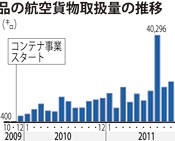
March 23, 2012 Ryukyu Shimpo
In the airfreight container project instituted by the Okinawa Prefectural Government (OPG), which is designed to expand the market for Okinawan products, the volume of products carried by air in the 2011 fiscal year increased about 43 times on a monthly average basis in comparison to those of November 2009 (before the project started). The increase was about 83% compared with that of fiscal 2010. The project has started to come into its own.
A representative of the OPG said, “The international cargo hub operation developed at Naha Airport by All Nippon Airways (ANA) has greatly contributed to the promotion of Okinawan products. We have succeeded in increasing exports of dressed meats and green goods as well as processed foods. Exports have been on the up this year.” The OPG expects further expansion of exports.
The project hires space in air cargo containers to carry Okinawan products from Naha Airport to Asian cities such as Hong Kong and Shanghai, where ANA operates cargo flights. Although the transaction volume only amounted to a monthly average of 0.4 tons before the project started, the volume in the 2010 fiscal year reached 9.4 tons. This increased to 17.2 tons during the period from April 2011 to January 2012 in the 2011 fiscal year. Thanks to an exhibition of products held in Hong Kong last August transaction volume reached 40.2 tons, the highest ever figure.
A representative of the OPG said, “Okinawan products attracted great interest from consumers in Hong Kong. We are aware of the heightened visibility of our products and want to keep promoting farm goods, livestock products and processed foods from Okinawa by actively holding exhibitions of products in the future.”
By category of available product in the 2011 fiscal year, green goods such as mushrooms, goya and cucumbers accounted for the largest percentage at 36%, livestock products such as pork, beef and eggs accounted for 15%, processed foods such as pork luncheon meat and frozen food for 13% and cold beverages for 8%. It is reported that Okinawan cuisine dishes made with fresh ingredients were popular in the restaurant in a hotel during the exhibition held.
(English translation by T&CT, Mark Ealey)
Go to Japanese
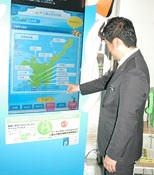
March 26, 2012 Ryukyu Shimpo
On March 15, digital information panels are now fully operational at three locations in Ishigaki – Ishigaki Airport Terminal, a municipal market and the Remote Island Terminal. The digital panels were set up with funding from the Okinawa Prefectural Government for use in the tourism industry. They are offer information in Japanese, English, Chinese and Korean.
The digital panels offer information not only on tourist facilities in Yaeyama and restaurants, but for events, typhoon warnings, and about dangerous marine life. They have a 55-inch screen and users can operate them simply by touching the screen. It is possible to see a displayed page on a mobile phone by scanning the QR code.
At the unveiling ceremony held at the airport terminal March 15, Ishigaki Mayor Yoshitaka Nakayama stated, “With the completion of new airport, the number of tourists from abroad will increase. We are very grateful for the installation of an information system that can provide details of local events for a range of tourists.”
Shigemi Toma, the chief of the Yaeyama Office of the Okinawa Prefectural Government, read out a message from Governor Hirokazu Nakaima, saying, “The digital panels make it possible to deliver tourism information about Yaeyama much more effectively. The number of foreign tourists is growing these days, so this will help promote tourism on Ishigaki and its neighboring islands.”
(English translation by T&CT, Lima Tokumori and Mark Ealey)
Go to Japanese

March 27, 2012 Ryukyu Shimpo
On March 26, the Okinawa Municipal Historiographic Office held a memorial service for the children who died between 1945 and 1949 in the Koza Orphanage, which was located in what is now the Sumiyoshi area. Twenty-two people who lost their parents and spent their childhood in the orphanage attended the service and prayed for their now deceased friends to rest in peace. The deceased have no living relatives. The people also visited an exhibition of the Koza Orphanage at the Okinawa City Gallery of Postwar Culture and History called Histreet 2, and the former orphanage building, which has been preserved by the owner of the building. The participants looked at photos of the time and the building with as they remembered low points in the past. They decided to see each other more and to talk about the postwar days, so as not to forget the terrible lessons from the war.
It was the second memorial service held since 2010. People involved in some way with Koza Orphanage organized the service, collected information and documents about war memories to pass on the history to the next generation. On the day of the service, participants planted a cherry tree by the orphanage and promised to hold a service every year in the cherry blossom season.
Seventy year-old Morisada Nishihira attended the service with his wife Akiko, sister Sadako Tajima and sister-in-law Toshiko Nishihira. He lost his father Moritsune and mother Tsuru during the terrible ground battles in the southern part of Okinawa Island. He finally arrived in the orphanage with his other four brothers and sisters but his sister Takako died of malnutrition. Nishihira said, “I lost my parents early in my life and all I could do was concentrate on my own survival. I would like to meet other people with the same experience and try to come to terms with my past.”
(English translation by T&CT, Shinako Oyakawa and Mark Ealey)
Go to Japanese
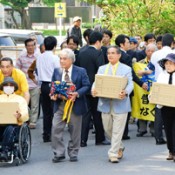
March 31, 2012 Ryukyu Shimpo
On March 30, 3129 people living around U.S. Marine Corps Air Station Futenma, including the residents of Ginowan, Urasoe and Kitanakagusuku, filed a law suit with the Okinawa Branch of Naha District Court seeking to halt the noise from the base during the early morning and evening and seeking compensation for damage caused by noise pollution. This is the second time that local people have taken legal action over aircraft noise from Futenma Air Station. The number of plaintiffs for the second suit is about eight times greater than the 404 plaintiffs in the first lawsuit in 2002. This is the largest number of plaintiffs in a single lawsuit since the file lodged against Kadena Air Base in which local residents took legal action in an attempt to return the quieter days of the past.
In the complaint, the plaintiffs seek to halt noise over 40 decibels at night in the local residential area around the base from 7:00pm to 7:00am and over 65 decibels during the day from 7:00am to 7:00pm. The people demand a total of approximately 5.1 billion yen in compensation, including 34500 yen per month and future claims for the next year.
The residents seek to halt the noise from the base during the evening and also during the day, which effectively means demanding a ban on the flight activities in and out of Futenma Air Station. The lawsuit seeking to stop the flight activities of the U.S. military in Japan has been dismissed on the grounds that the Japanese government has no authority to halt them or that they have no authority over a third party. The plaintiffs and their legal team insist that their rights are constitutionally-guaranteed, and state that the Japanese government should be obliged to stop the flight operations because it has provided the facilities to the U.S. military.
At the first lawsuit, residents filed against the Japanese government and the base commander, seeking to stop noise from the base and its flight activities. In 2010, the Naha Branch of the Fukuoka High Court ordered the government to pay compensation for illegal noise damage to the plaintiffs, but it dismissed their demand to stop the flight activities based on the third party theory.
Outline of the plaintiff’s legal claims in the 2nd Futenma Aviation Noise Lawsuit:
(a) The government should not permit noise pollution from the U.S. Marine Corps Air Station Futenma in excess of 40 db in residential areas from 7:00pm to 7:00am.
(b) The government should not permit noise pollution in residential areas in excess of 65 db from the flight operations of USMCAS Futenma from 7:00am to 7:00pm.
(c) The government should pay compensation for delayed damages of 898112 yen to a plaintiff participating in the first and second lawsuits, and 1242000 yen to a plaintiff of the second lawsuit.
(d) The government should pay compensation of 34500 yen per month per person for one year from the end of the oral argument of this case.
(English translation by T&CT, Mark Ealey)
Go to Japanese
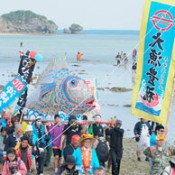
March 26, 2012 Ryukyu Shimpo
On Henza Island in Yonashiro, Uruma for three days from March 24, or March 3 on the lunar calendar, the traditional ceremony sangwacha was held. On nakanuhi, or the middle day of March 25, a tudanuiyu ceremony was held to pray for a good catch, safety, health and prosperity, and the nanzamoi ceremony to cross the ocean to Oiwa Nanza, which is located to the east off of the island.
During tudanuiyu, the Henza Sanshin Club sang and played songs for karii zuke (preliminary celebration) and 81 year-old noro (hereditary sacred woman) Tomeko Kamura handed a glass of prayer wine to community association President Tomio Matsuda. When women from a newly established group, Usudeku Chorus sang kaminchu songs, and Senior Club Vice President Sumiko Tamanaha sang a line “nail a big harpoon,” taman (Lethrinus nebulosus) on a cutting board was nailed and raised. After that, students from Henza Junior High School carried a portable taman shrine and offered their prayers.
(English translation by T&CT, Megumi Chibana and Mark Ealey)
Go to Japanese

Go To Video
March 27, 2012 Ryukyu Shimpo
In the 2011 fiscal year Naha Port recorded its highest ever container load handling volume, a total of 213919 TEU (Twenty-foot Equivalent Unit – a 20 foot long container), an increase of 3.3% over the previous year. This is a preliminary calculation carried out by the Naha Port Authority on March 26 from the total volume of containers (exports and imports), and domestic shipments. At the same time, the percentage of the total load handling made up of container load handling increased in fiscal 2011, accounting for 204382 TEU, including export and domestic shipments, an increase of 5.4% over the previous year. These figures suggest that cargo for exports from Okinawa has become somewhat sluggish.
The volume of overseas container cargo for export from Okinawa was 18302 TEU, an increase of 4.2% over the previous year. The volume of container load handling for export has increased steadily. The total amount of import and export was 63249 TEU, an increase of 6% over the previous year. However, the volume for export accounted for less than 30% of the total container load handling.
At the same time, the volume of empty containers for export was 24600 TEU, 1.1% up on the previous year, but less that the 25223 TEU of fiscal 2002. The volume of empty containers for export decreased to 10862 TEU in fiscal 2007, and since that year there has been an upward trend.
The volume of containers loading goods for the domestic market has increased slightly at 18063 TEU, an increase of 24.3% compared to the figure in fiscal 2002, while the amount of empty containers has risen to 179782 TEU, an increase of 52.6% over fiscal 2002, indicating that the rate of increase is high.
A representative of the Naha Port Authority pointed out the need to reduce logistics costs by eliminating the volume of empty containers for export to both overseas and domestic markets, because the unbalance between the volume of containers loading goods and empty containers in the delivery and transport system results in high transportation costs. The association is now working on a social experiment to cope with this problem, and is striving to achieve a less than a container load or LCL for export to Asia. On March 26, the association reported the preliminary figures of container load handling in fiscal 2011 at the meeting for the Okinawa International Logistics Operation Team held at the Naha Office of Cabinet Office, Government of Japan.
(English translation by T&CT, Mark Ealey)
Go to Japanese

March 27, 2012 Ryukyu Shimpo
The Okinawa Contents Bazaar was held on March 25 and 26 in the 4th Okinawa International Movie Festival, at the Okinawa Convention Center, Ginowan City. About 20 production companies and visual artists from the United States and Asia came to the venue to meet Japanese counterparts such as representatives of digital television stations and production companies, to discuss how to produce digital video content for the global marketplace. This event aims to launch Japanese content from Okinawa to the world market, and it started when the 2nd Okinawa International Movie Festival was held. The people and companies involved plan to produce the content format in collaboration with counterparts in the United States and Asia, and to exhibit their work on the world stage at the likes of future international television festivals.
At the meeting, 20 Japanese companies, including representatives of television stations in Tokyo, Osaka, Nagoya, publishing companies and companies producing digital video and games and overseas enterprises such as production companies from the United States, South Korea, China, Hong Kong, Taiwan and Thailand participated. At the same time, a digital content exhibition for local people including virtual games and drama was held until the last day of the festival on March 30.
(English translation by T&CT, Mark Ealey)
Go to Japanese
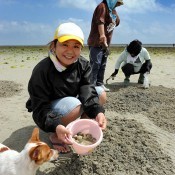
March 24, 2012 Ryukyu Shimpo
On March 24, which is May 3 in the lunar calendar, a ceremony called hamauri was held at beaches around Okinawa. Every year, Okinawan people go to the beaches where they soak their hands and feet in seawater to cleanse themselves as they pray for their well-being. On March 23, the day before hamauri, at beaches around Okinawa, many people took advantage of the fine weather as they enjoyed gathering shellfish.
“I love the sea, so I come here every year. Last year, we didn’t find many shellfish, but today I did,” said Satsuki Arakaki, who visited Awase mudflat in Okinawa City with her family. She displayed her bucket full of asari or Manila clams and said with a smile, “They taste great in miso soup.”
(English translation by T&CT, Lima Tokumori and Mark Ealey)
Go to Japanese

Go To Video
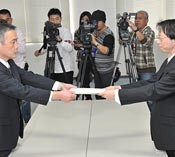
March 28, 2012 Ryukyu Shimpo
On March 27, a representative of the Civil Engineering and Construction Division of the Okinawa Prefectural Government (OPG) submitted a written statement of opinion from Governor of Okinawa Hirokazu Nakaima to Okinawa Defense Bureau (ODB) with regard to the land reclamation work described in the environmental impact assessment report (EIA) put together by the ODB as part of the plan to construct an alternative facility for the relocation of Futenma Air Station to Henoko, Nago. As Nakaima wrote in the statement submitted to the ODB at the end of February on the planned construction of an airfield for the project, it would not be possible for the environmental protection policy and other measures proposed by the government in the EIA to suffiently conserve the living and natural environment around the area in question. Nakaima has demanded the relocation of Futenma Air Station out of Okinawa, and an early return of the land used by the base. He also pointed out problems in the EIA in 404 cases with 38 items such as the lack of naming of suppliers for about 80 percent of the voluminous soil needed to fill the land. This requires about 17 million cubic meters of soil. Also there is a lack of a clear transportation plan and insufficient studies on the impact on the habitat of the dugong, an endangered marine mammal, and sea-grass beds off Henoko.
In response to the governor’s statement of opinion, the Okinawa Defense Bureau will revise the environmental impact assessment report and resubmit it to the OPG.
In Tokyo on the evening of the same day, Defense Minister Naoki Tanaka stated that the government intends to set up a third-party panel to revise the EIA.
Kiyokatsu Toma, the head of the Civil Engineering and Construction Division, who held a press conference at the Okinawa Prefectural Office, explained, “The report was significantly lacking in terms of environmental protection policy. For example, a soil procurement plan was not included.” Although Toma did not give an immediate response with regard to the governor’s judgment on approval of the land reclamation work, division staff repeatedly asserted that the revisions in the EIA would be crucial in determining whether or not the OPG would approve the land reclamation work.
In his opinion on the EIA, Nakaima urged the central government to specify suppliers of soil to fill the land and to provide a transportation plan. He also pointed out issues related to the degradation of the habitat of the dugong, the reduction of the sea-grass beds and the lack of environmental protection policies. Nakaima went on to state that the loss of water through the building of a work yard (5.1 hectares) for the construction of the base in Henoko is unacceptable and that reclamation work could close up the mouth of the Mija River, which could make it difficult to maintain the ecosystem, and therefore demanded that the central government amend the plan.
Asanori Gima of the division submitted a written statement of opinion to Osamu Ogiya of the bureau in Kadena Town in the afternoon on March 27.
Nakaima submitted his written statement of opinion on the EIA regarding the planned construction of an airfield for the project to the ODB on February 20, pointing out that there are 175 problems in the EIA in 25 areas such as the planned deployment to Futenma of the MV-22 Osprey vertical takeoff and landing aircraft. The central government is expected to submit the revised EIA to the OPG sometime after May. It will be officially announced and inspected within one month of being submitted. The central government is then expected to apply to the OPG for approval of the land reclamation work based on the Public Water Body Reclamation Act.
(English translation by T&CT, Mark Ealey)
Go To Japanese

March 23, 2012 Ryukyu Shimpo
Mezzo soprano singer Sayaka Shigeshima from Nanjo has signed a two-year contract to perform with the Weimar National Theater in Germany from September. Her first performance, in October, will be Verdi’s Falstaff in which she plays the role of Meg, who receives a love letter from the main character. Shigeshima said, “I am very happy to be performing in the theater that I have also longed to be part of. I will do my very best in this role.”
Shigeshima completed her post-graduate studies at the Okinawa Prefectural University of Arts and has studied at the University of Music and Performing Arts Munich since 2007. She was awarded the grand prize at the Okiden Sugar Hall Competition and Debut Concert in 2010 and now sings in the choir of the Bavarian National Theater. According to Professor Tetsuo Koike, who once taught Shigeshima, it is rare for the theater to sign an exclusive contract with Japanese singer.
More than 100 mezzo soprano singers went to audition for the Weimar National Theater. Shigeshima commented, “It was the biggest audition I have ever had so I was nervous, but I did my very best. I may find it difficult in a different culture, but I will try to enjoy the experience and sing to my best.”
(English translation by T&CT, Shinako Oyakawa and Mark Ealey)
Go To Japanese











 Webcam(Kokusai Street)
Webcam(Kokusai Street)


